Oxford Street: Wooing shoppers back to Europe's busiest high street
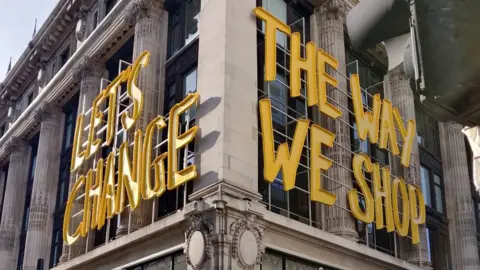 BBC
BBC"Let's change the way we shop."
This is the statement emblazoned in huge letters on the side of one of the most famous department stores in the world, in Europe's busiest shopping area - Selfridges on Oxford Street.
Over the past year, as restrictions have been put in place to stop the spread of coronavirus, consumers have been forced to alter the way they shop, with many turning to online retailers.
Now, as stores are allowed to reopen, what's left on London's most famous shopping street?
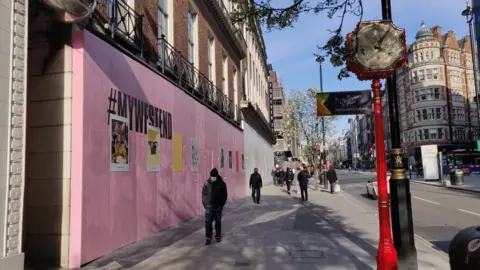
Walk the entire street noting down all of the defunct stores and you will find that 28 out of 212 shops - over 13% - are either boarded up or their occupants have clearly left for the last time.
Topshop, at the heart of Oxford Street, is probably the most famous casualty. If you peek through the windows you'll see a few undressed mannequins - a far cry from its heyday when supermodel Kate Moss drew huge crowds to the store.
But it is not the only one: Debenhams and Evans are brands that have closed for good. Many other companies have consolidated their store portfolios on the street - gone are the days where brands would have multiple outlets along the 1.2-mile (2km) stretch of road. Next and Boots have one flagship store, whereas before the pandemic they had two or three.
By comparison, the only shop boarded up on Regent Street is US fashion store J Crew, which closed before the pandemic. On Bond Street there are a few boarded-up stores but at the place where it connects with Oxford Street - the luxury end, full of fashion brands such as Chanel, Dior and Versace - it remains unscathed.

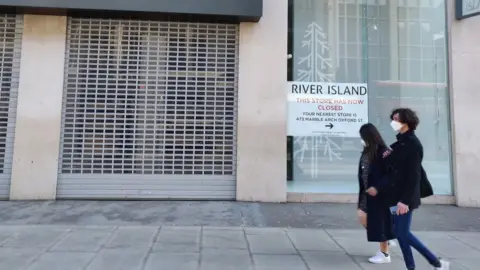
It's a trend many have long seen coming, including James Daunt, the managing director of bookstore chain Waterstones, who closed its shop on the street to make way for the Next flagship in 2016.
Then, he told me: "We're moving from a position where we have shops dotted all over, instead there'll be fewer bigger and distinctive ones."
He added: "Stores need to be really good, otherwise why bother going in?"
It's a question many, including Jace Tyrrell, chief executive of the New West End Company, are trying to answer.
"What's been really obvious in the last 10 years is we've really lost Londoners wanting to come to the West End and Oxford Street particularly," he said, adding that about 20-30% of shops in the area would change, partly because of closures that were happening across the country - for instance, Topshop and Debenhams - but some because of new developments.
He said fashion - what Oxford Street is best known for - was changing: "If you look at Adidas, look at Selfridges, look at Primark, they've all got different business models so I think its [Oxford Street's] spiritual home will always be fashion, it'll just have to cater to different types of customers."
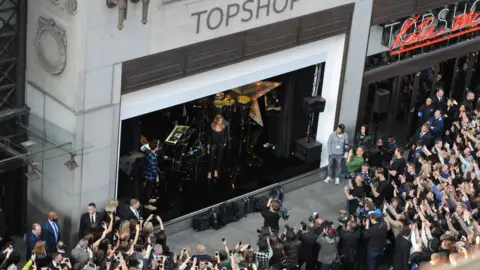 Getty Images
Getty Images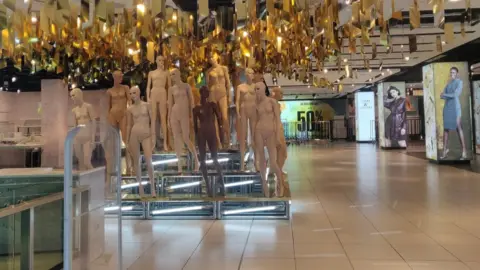
The opening of the Westfield shopping centres in White City and Stratford, in 2008 and 2011 respectively, played a part in diverting Londoners away from the centre.
Before Covid, the area New West End Company represents - Oxford Street, Regent Street and Bond Street - turned over about £10bn a year, half of which was from tourism. With foreign tourists unable to return for the foreseeable future and 15 outlets on the street catering only to foreign exchange or souvenirs, retailers have to work harder to bring UK customers back.
New West End Company hopes to see sales return to this figure by 2023, but how?
"The West End is not just retail; we have theatres, restaurants, cultural institutions," said Mr Tyrrell.
"Of course retail will be there, but we want to attract people to come to the city centre.
"We want to have the very best sports facilities in the world on that street, we want to have Netflix open a studio - we've got to create a sense of prominence and showcase. It's not necessarily the full driver of why you would come to Oxford Street in the future, it's part of the mix."

He said there was one store on the street that was getting things right: Selfridges.
"We need to do a Selfridges on the whole street from Marble Arch to Centrepoint. They've absolutely smashed it in terms of customer first, sustainability approach. The 'experience' - everything we talk about is in that building - and we need to do that on the whole street end to end."
Lindy Woodhead, a fashion industry expert who was the first female board member at Harvey Nichols, knows a lot about Selfridges, having written the book Shopping, Seduction & Mr Selfridge, which was later turned into a popular drama series on ITV.
She says the main reason people want to visit Selfridges is the building.
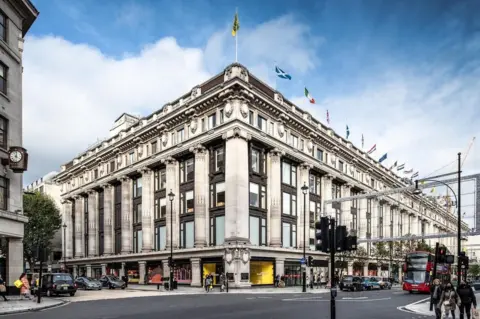 Historic England
Historic England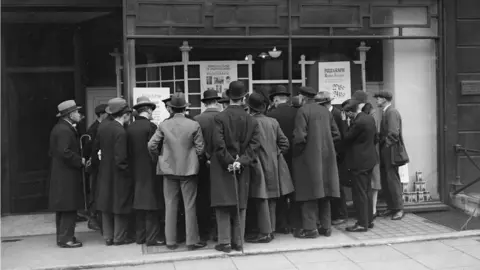 Getty Images
Getty Images"The first thing you have to have (to have a successful shop) is a beautiful building, because if you don't have somewhere where the public wants to go, no matter what you're selling, they're not going to go there," she said.
But it's also the store's "DNA from way back when Harry Selfridge opened it," she added.
"He had restaurants in that store, he had washrooms in that store, he had toys for the boys: men could learn to fly an aeroplane in that store - he had a flight simulator. He had golf pros giving golf lessons; you had famous footballers making personal appearances, he had a book department that when it had cookery books there were demonstrations.
"He put on in-store fashion shows, cultural exhibitions, scientific exhibitions. They launched television there - John Logie Baird launched television for the first time in 1926.
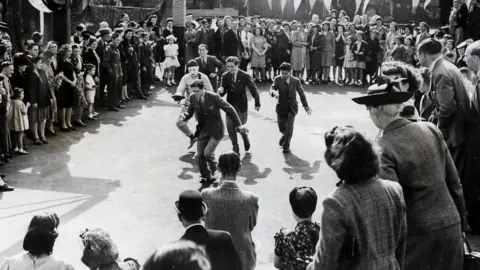 Getty Images
Getty Images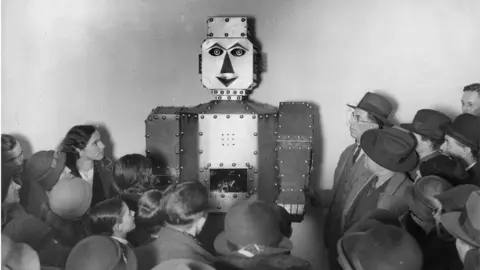 Getty Images
Getty Images"He had the BBC on the roof broadcasting, he had a playlist and a DJ - you can't think that this entertainment wasn't a wow factor because it was.
"So that wow factor has to happen today to engage different clans of consumers into a shop or store and a different strand of consumer is entirely based on their hobbies, their passions, what are they in love with and of course their income.
"You have to have a mixture of desire and thrill and excitement and culture. And if you don't have those things, then people will be bored and if people are bored then they're not going to go in. And if there's nothing else for them to shop or buy in that area, then they're not going to go to that area.
"What's happening in Regent Street and across over to Oxford Circus is absolutely wonderful but walk slowly and carefully as you did, up and down so much of it [Oxford Street], especially the western end, and it's very depressing.
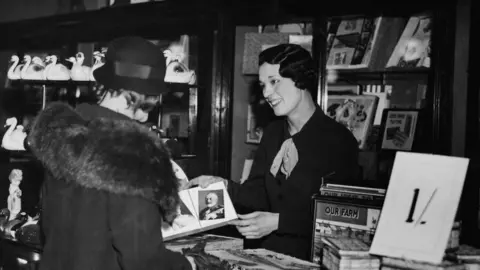 Getty Images
Getty Images"It's not just about the merchandise and the desirability of what's going on sale in these shops - there is no café culture: where is the museum, where is the history of Oxford Street, where is a museum about the gallows that were at Marble Arch, where are the things that would attract tourists to the street?
"What has happened to Oxford Street over the years is that because the street is so big and so dirty and so bland there's just pockets of excellence where it connects to a cross street that's interesting.
"Because the traffic planning has been so bad - it's improved a lot over the last four to five years - but pre-Covid it was never somewhere you wanted to go unless you were going to your destination.
"And mainly your destination, it has to be said, was Selfridges."
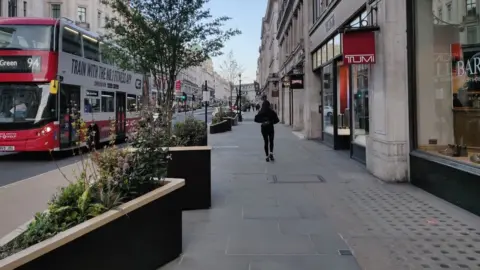
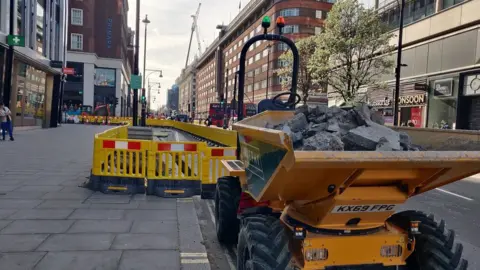
Part of Westminster City Council's reimagination of the area is to increase the amount of greenery.
As part of its £150m refurbishment of the area, more trees and plants are being planted and "pocket parks" are being built by consolidating bus bays to make space for play areas and lighting installations.
In its Oxford Street framework, it wants to focus on four elements - "greener, smarter, future, together" - which it hopes will create the right environment for businesses and others to want to invest in.
But these are for the most part just plans at the moment.
The reality is that it has proved to be very difficult to attract new businesses over the past year; the former HMV and Forever 21 plots that were vacated in 2019 remain empty.
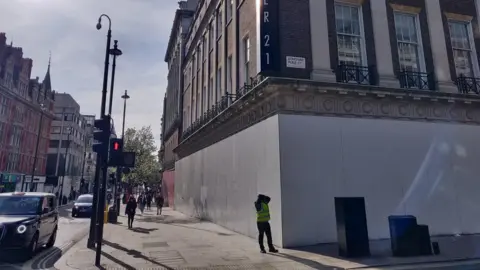
For all the talk about Selfridges and its "successful DNA", it hasn't had an easy time of late either; the retailer announced its total workforce across its four stores in England would be cut by 14%, with 450 roles closed.
It hopes to return strongly this year, and intends to offer floristry workshops, pampering sessions, out-of-hours children's parties in the toy department and private screenings at The Cinema at Selfridges.
It's also bringing back DJs who will play live sets throughout the day; customers can text song requests while they shop.
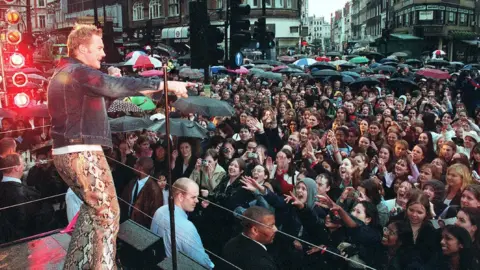 Getty Images
Getty Images Getty Images
Getty ImagesMusic will also play a part in all of Oxford Street thanks to a partnership with Spotify which will allow shoppers to download playlists specifically curated for the shopping area by looking out for codes dotted throughout the street.
The associated costs of having a business on the street is something many are looking for help with from the government and landlords.
"The original Selfridge ethos was that it doesn't matter if you come in and you're just looking - we don't mind. But a lot of shops can't afford to do that today because their rates are so high that their prices are fixed," said Ms Woodhead.
According to real estate advisory firm Altus Group's annual business rates review in 2019, Oxford Street had the country's highest rateable value at £7,549 per metre squared. New Bond Street was second at £5,675.
To help with the costs of the pandemic, Chancellor Rishi Sunak gave businesses a "holiday" from paying the property tax. This will continue until the end of June, with discounts in place until next year.
Lord Wolfson, the boss of one of the country's most resilient brands, Next, has urged the government to cut business rates to reflect the changing marketplace.
"In-store sales at Next have gone down 25% since 2015 but our rates on those properties have gone up 9%. They have become unfair because they no longer reflect the value property against which they're charged," he said, adding that the value of High Street retail properties had fallen dramatically in the crisis "but the business rates bill hasn't reflected that".
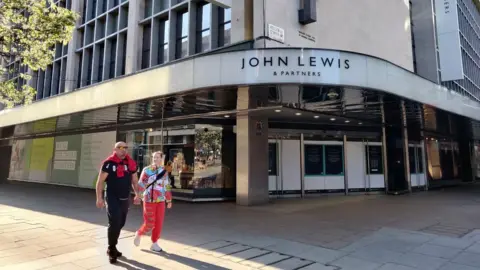
Covid-19 forced those who normally work in an office to stay at home.
Pre-Covid, about 155,000 people worked in offices above shops in Oxford Street. Retailers such as M&S and John Lewis are currently converting the top levels of their stores into office space.
Mr Tyrrell doesn't see the area losing out post-Covid.
"It'll be the same as retail, there'll be fewer offices left but the ones that are left will have everything and that'll be part of a reason to go into the office.
"Where would you rather work - the centre of Oxford Street or way out in London?"
While many people have become accustomed to buying online over the past year, there's one thing this mode of retail can never offer: human interaction.
"I think there'll be a premium placed on human-to-human experience in the future and that's what Oxford Street needs to become relevant to," Mr Tyrrell added.
"What's the future of office demand, what's happening in retail, what's happening to tourism - none of us fully know yet. The next six months really are the key to understand what's going to stick post-Covid."
